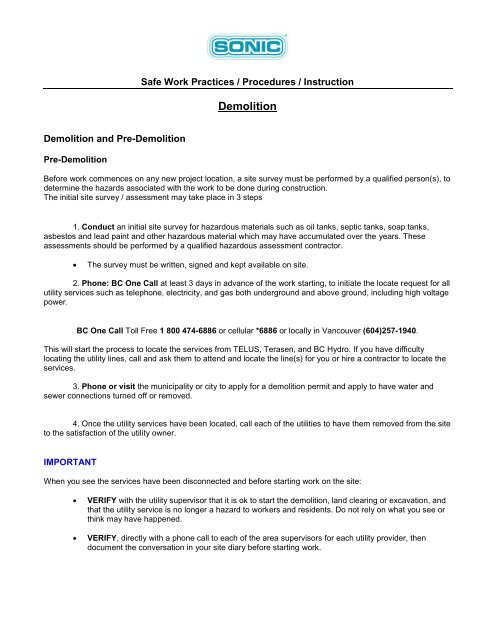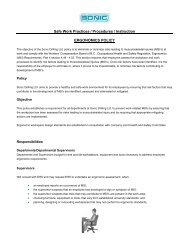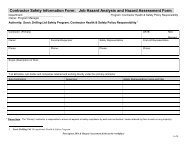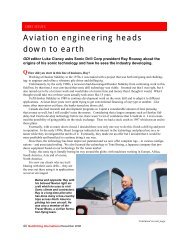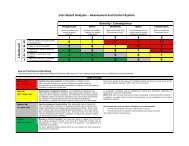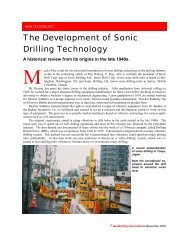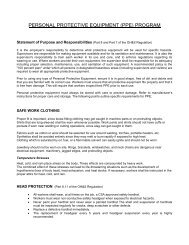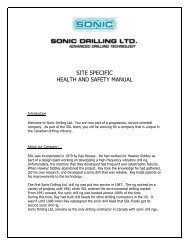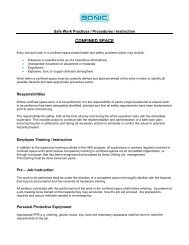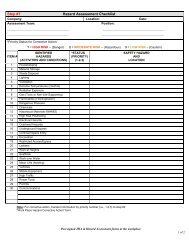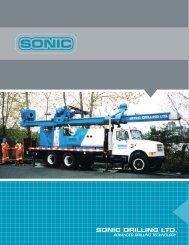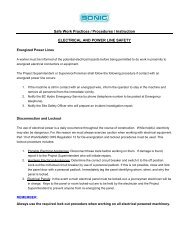Demolition - Sonic Drilling Ltd.
Demolition - Sonic Drilling Ltd.
Demolition - Sonic Drilling Ltd.
- No tags were found...
You also want an ePaper? Increase the reach of your titles
YUMPU automatically turns print PDFs into web optimized ePapers that Google loves.
Safe Work Practices / Procedures / Instruction<strong>Demolition</strong><strong>Demolition</strong> and Pre-<strong>Demolition</strong>Pre-<strong>Demolition</strong>Before work commences on any new project location, a site survey must be performed by a qualified person(s), todetermine the hazards associated with the work to be done during construction.The initial site survey / assessment may take place in 3 steps1. Conduct an initial site survey for hazardous materials such as oil tanks, septic tanks, soap tanks,asbestos and lead paint and other hazardous material which may have accumulated over the years. Theseassessments should be performed by a qualified hazardous assessment contractor.The survey must be written, signed and kept available on site.2. Phone: BC One Call at least 3 days in advance of the work starting, to initiate the locate request for allutility services such as telephone, electricity, and gas both underground and above ground, including high voltagepower.BC One Call Toll Free 1 800 474-6886 or cellular *6886 or locally in Vancouver (604)257-1940.This will start the process to locate the services from TELUS, Terasen, and BC Hydro. If you have difficultylocating the utility lines, call and ask them to attend and locate the line(s) for you or hire a contractor to locate theservices.3. Phone or visit the municipality or city to apply for a demolition permit and apply to have water andsewer connections turned off or removed.4. Once the utility services have been located, call each of the utilities to have them removed from the siteto the satisfaction of the utility owner.IMPORTANTWhen you see the services have been disconnected and before starting work on the site:VERIFY with the utility supervisor that it is ok to start the demolition, land clearing or excavation, andthat the utility service is no longer a hazard to workers and residents. Do not rely on what you see orthink may have happened.VERIFY, directly with a phone call to each of the area supervisors for each utility provider, thendocument the conversation in your site diary before starting work.
Safe Work Practices / Procedures / Instruction<strong>Demolition</strong> Work1 Prior to commencement of demolition work the supervisor must contact management to ensure that aWCB Notice of Project (N.O.P.) has been completed and submitted to the WCB if:total cost of labour and materials for the project exceeds $100,000; orall or part of the temporary works, except pre-engineered or premanufactured components, are requiredto be designed by a professional engineer, orthe activity involves the removal, encapsulation or enclosure of friable asbestos building materials, orthe activity involves demolition, dismantling, or repair of any part of a structure in which insulatingmaterials containing asbestos have been used, or in which asbestos products have been manufactured,the activity involves a significant disturbance of lead-containing coatings, oractivities may expose workers to a significant risk of occupational disease, orthe structure to be demolished is:i) a building, silo, chimney or similar structure more than 6 m (20 ft) in height, orii) a bridge, oriii) an earth or water retaining structure more than 3 m (10 ft) in height, oriv) workers will be working in a compressed air atmosphere or an underground working, tunnel,cofferdam, caisson, orv) the project includes a trench less than 3.7 m (12 ft) wide at the bottom, more than 1.2 m (4 ft) indepth and more than 30 m (100ft) in length that a worker may be required to enter, orvi) the project includes any other excavation more than 1.2 m (4 ft) in depth that a worker may berequired to enter.An inspection of the site must be undertaken for identification of asbestos, lead or other heavy metal ortoxic, flammable or explosive materials that may be handled, disturbed or removed.The inspection report referred to earlier must be made available at the work site, including any plans,drawings or specifications, as appropriate, to show the locations of hazardous substances.Any hazardous materials identified must be safely contained or removed.A <strong>Demolition</strong> Support Plan, as prescribed by a professional engineer, must be obtained, submitted to theWCB and Head Office and posted at the project location. (NOTE: If the nature and method of demolitionwill not endanger workers and the stability of adjoining grounds or structures will not be compromised, anengineered plan is not required.).The Plan must include a schedule, based on the stages of demolition, for installation of the supportsystem components. (NOTE: The temporary support system may be required to support the weight ofbuilding materials that remain on the floor as well as any equipment or machinery involved in thedemolition activities.)All potentially hazardous services (hydro, gas, water, sewer) must be disconnected.All glass and sash must be removed if it places workers at risk.
Safe Work Practices / Procedures / Instruction2 Where practicable, demolition must proceed from top to bottom of the structure.3 If hazardous materials that were not previously identified in the pre-job inspection are discovered duringdemolition work, work must cease until the materials are contained or removed.4 Before demolishing interior or exterior walls within 3 m (10 ft) of any opening in a floor immediately below,the hole must be securely covered and marked. standard symbol for marking covers for floor openings isa large Ø in red or orange paint) or workers must be removed from the lower levels and prevented accessuntil after the walls are demolished. Walls must not be left standing in an unstable, dangerous condition.5 Materials and debris from the demolition work must be promptly removed from the work location. If suchmaterial and debris is to be thrown from the building, the drop location must be barricaded against entry(structural members must be lowered rather than dropped from the building).6 Chutes provided for removal of masonry and other rubble and debris must be enclosed and gates orstops provided at each point of entry and discharge. The area of discharge must be barricaded againstentry or the chute must empty into a container. Warning signs stating "Danger - Chute – Sliding materials"must be posted adjacent to the chute outlet.7 Stairways and handrails must be left intact until they are no longer required to access a level.8 Work sheds, vehicles, porta-potties and tool boxes must be located away from the hazard of fallingmaterials.9 During demolition the supervisor must ensure:safe access and egress to and from work areas,work areas are arranged to allow safe movement of workers, materials and equipment,floor openings are guarded,handrails and stairways are left intact as long as possible,housekeeping is maintained,temporary lighting is provided.Emergency procedures are developed for:‣ Removal of injured worker‣ Evacuation‣ Fire‣ Accidental exposure to asbestos‣ Spill procedures


